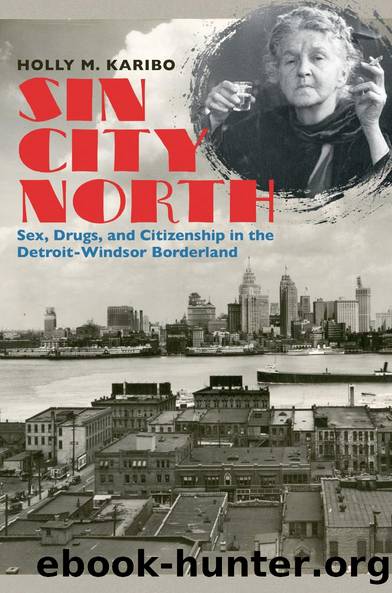Sin City North by Holly M. Karibo

Author:Holly M. Karibo [Karibo, Holly M.]
Language: eng
Format: epub
Tags: Social Science, Sociology, Urban
ISBN: 9781469625201
Google: 4ypyawEACAAJ
Publisher: University of North Carolina Press
Published: 2015-01-15T05:45:29+00:00
Hastings Street, the central corridor of Paradise Valley, before and during the urban renewal process. (Courtesy of the Walter P. Reuther Library, Wayne State University)
Across the river, Canadian municipal leaders looked to the example set by their American neighbor and began to take steps to fight vice, blight, and transience in Windsor. A bit late to the game, in 1959 the city of Windsor commissioned the foremost urban renewal expert in Canada, E. G. Faludi, to propose a project that would address the cityâs key problems. The resultant Faludi Study focused on trends common across the border region, including an emphasis on suburbanization and the corresponding deterioration of industrial neighborhoods. Central to the study was the desire to redevelop so-called blighted areas and to rezone neighborhoods to facilitate a desirable mix of residential, commercial, and manufacturing spaces. According to the report, one of the main goals was âto save the City and the fringe areas from further deterioration and to reduce blight by the application of an urban renewal programme consisting of protective, preventative and curative measures.â42 This was, in part, a response to the fact that by the late 1950s, many industrial sites sat vacant, and the land was deemed not only unsightly but also dangerous because it provided locations where illegal activities could take place. The closing of many factories also had a negative impact on the surrounding communities, the report noted, and residential properties began to suffer because of the ownersâ lack of income.
The Faludi Study concluded that two developments were at the heart of Windsorâs urban problems: the cityâs inability to attract the necessary level of industrial development and the increasing rate of suburbanization. As residents moved to the suburbs in large numbers, services deteriorated in the downtown core. According to the study, âIn contrast to the rapid suburbanization ... the central parts of the City, residential, commercial, and industrial, are declining and give little incentive for improvement.â43 Significantly, âthe pattern of the outward growth is disorderly and haphazard but the inward decline is continuous and uniform. Undoubtedly much of the urban blight in the central core of the City is due to the functional defects in many parts of the structure of the City.â Maps the researchers created further demonstrate that blighted areas tended to develop along industrial sites near the Detroit River and on streets within the downtown core. It also made clear that the economic disparities between suburban and downtown neighborhoods were directly linked to the upkeep of properties and the conditions of local infrastructure.
Contemporaries asserted that there was a direct link between the trends identified in the Faludi Study and the issues of vice and social welfare. To appease these concerns, the report asserted that its fifteen-year program, if undertaken, would have a direct impact on the social conditions of the city of Windsor in four main ways: first, by âeliminating slum conditionsâ; second, by âreducing incidents of crime, disease and fire hazardsâ; third, by âhalting the trend of decline all over
Download
This site does not store any files on its server. We only index and link to content provided by other sites. Please contact the content providers to delete copyright contents if any and email us, we'll remove relevant links or contents immediately.
| Americas | African Americans |
| Civil War | Colonial Period |
| Immigrants | Revolution & Founding |
| State & Local |
In Cold Blood by Truman Capote(3340)
The Innovators: How a Group of Hackers, Geniuses, and Geeks Created the Digital Revolution by Walter Isaacson(2971)
Steve Jobs by Walter Isaacson(2853)
All the President's Men by Carl Bernstein & Bob Woodward(2343)
Lonely Planet New York City by Lonely Planet(2187)
And the Band Played On by Randy Shilts(2162)
The Room Where It Happened by John Bolton;(2130)
The Poisoner's Handbook by Deborah Blum(2107)
The Murder of Marilyn Monroe by Jay Margolis(2074)
The Innovators by Walter Isaacson(2070)
Lincoln by David Herbert Donald(1960)
A Colony in a Nation by Chris Hayes(1897)
Under the Banner of Heaven: A Story of Violent Faith by Jon Krakauer(1763)
Being George Washington by Beck Glenn(1762)
Amelia Earhart by Doris L. Rich(1667)
The Unsettlers by Mark Sundeen(1657)
Dirt by Bill Buford(1646)
Birdmen by Lawrence Goldstone(1635)
Zeitoun by Dave Eggers(1611)
